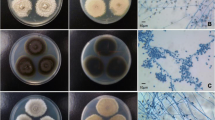Abstract
Aero-tolerant Actinomyces spp. are an under-recognised cause of cutaneous infections, in part because identification using conventional phenotypic methods is difficult and may be inaccurate. Matrix-assisted laser desorption ionisation time-of-flight mass spectrometry (MALDI-TOF MS) is a promising new technique for bacterial identification, but with limited data on the identification of aero-tolerant Actinomyces spp. This study evaluated the accuracy of a phenotypic biochemical kit, MALDI-TOF MS and genotypic identification methods for the identification of this problematic group of organisms. Thirty aero-tolerant Actinomyces spp. were isolated from soft-tissue infections over a 2-year period. Species identification was performed by 16 s rRNA sequencing and genotypic results were compared with results obtained by API Coryne and MALDI-TOF MS. There was poor agreement between API Coryne and genotypic identification, with only 33% of isolates correctly identified to the species level. MALDI-TOF MS correctly identified 97% of isolates to the species level, with 33% of identifications achieved with high confidence scores. MALDI-TOF MS is a promising new tool for the identification of aero-tolerant Actinomyces spp., but improvement of the database is required in order to increase the confidence level of identification.
Similar content being viewed by others
References
Clarridge JE 3rd, Zhang Q (2002) Genotypic diversity of clinical Actinomyces species: phenotype, source, and disease correlation among genospecies. J Clin Microbiol 40:3442–3448
Gómez-Garcés JL, Burillo A, Gil Y, Sáez-Nieto JA (2010) Soft tissue infections caused by Actinomyces neuii, a rare pathogen. J Clin Microbiol 48:1508–1509
Wade WG, Könönen E (2011) Propionibacterium, Lactobacillus, Actinomyces, and other non-spore-forming anaerobic gram-positive rods. American Society of Microbiology, Washington, D.C.
Funke G, Renaud FN, Freney J, Riegel P (1997) Multicenter evaluation of the updated and extended API (RAPID) Coryne database 2.0. J Clin Microbiol 35:3122–3126
Bosshard PP, Abels S, Zbinden R, Böttger EC, Altwegg M (2003) Ribosomal DNA sequencing for identification of aerobic gram-positive rods in the clinical laboratory (an 18-month evaluation). J Clin Microbiol 41:4134–4140
Seng P, Drancourt M, Gouriet F, La Scola B, Fournier PE, Rolain JM, Raoult D (2009) Ongoing revolution in bacteriology: routine identification of bacteria by matrix-assisted laser desorption ionization time-of-flight mass spectrometry. Clin Infect Dis 49:543–551
Relman DA, Falkow S (1992) Identification of uncultured microorganisms: expanding the spectrum of characterized microbial pathogens. Infect Agents Dis 1:245–253
Turner S, Pryer KM, Miao VP, Palmer JD (1999) Investigating deep phylogenetic relationships among cyanobacteria and plastids by small subunit rRNA sequence analysis. J Eukaryot Microbiol 46:327–338
Clinical and Laboratory Standards Institute (CLSI) (2008) Interpretive criteria for identification of bacteria and fungi by DNA target sequencing; Approved Guideline MM18-A. CLSI, Wayne, PA
Santala AM, Sarkonen N, Hall V, Carlson P, Jousimies-Somer H, Könönen E (2004) Evaluation of four commercial test systems for identification of actinomyces and some closely related species. J Clin Microbiol 42:418–420
Croxatto A, Prod’hom G, Greub G (2011) Applications of MALDI-TOF mass spectrometry in clinical diagnostic microbiology. FEMS Microbiol Rev (in press). doi:10.1111/j.1574-6976.2011.00298.x
Acknowledgements
This work was supported by an NMRC Enabling (Small) Grant from the National Medical Research Council, Singapore. We would like to thank Dr. Prabha Krishnan and the staff of Tan Tock Seng Hospital, and Bruker Daltonics Singapore for the use of the MALDI Biotyper.
Author information
Authors and Affiliations
Corresponding author
Rights and permissions
About this article
Cite this article
Ng, L.S.Y., Sim, J.H.C., Eng, L.C. et al. Comparison of phenotypic methods and matrix-assisted laser desorption ionisation time-of-flight mass spectrometry for the identification of aero-tolerant Actinomyces spp. isolated from soft-tissue infections. Eur J Clin Microbiol Infect Dis 31, 1749–1752 (2012). https://doi.org/10.1007/s10096-011-1496-3
Received:
Accepted:
Published:
Issue Date:
DOI: https://doi.org/10.1007/s10096-011-1496-3




